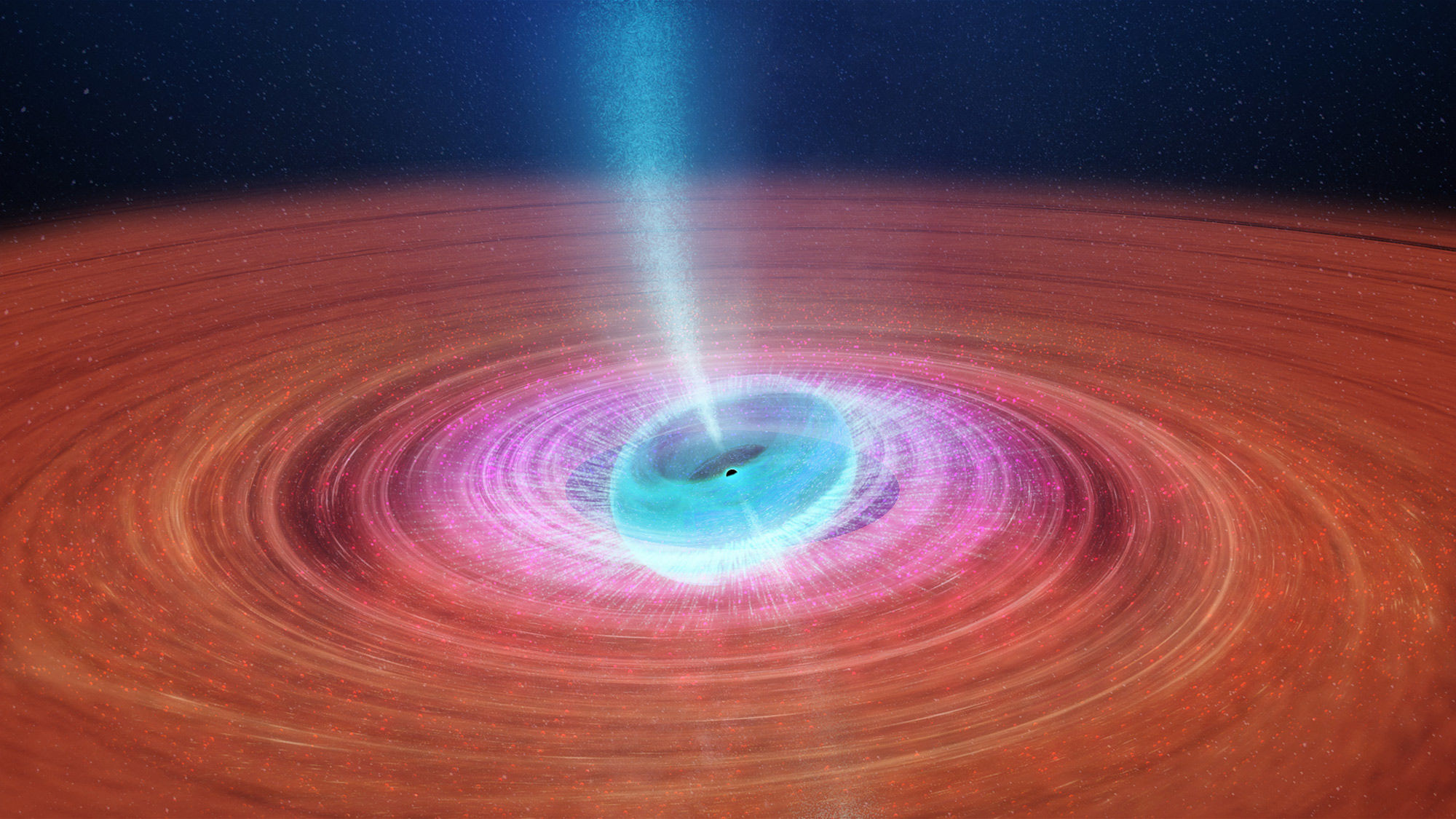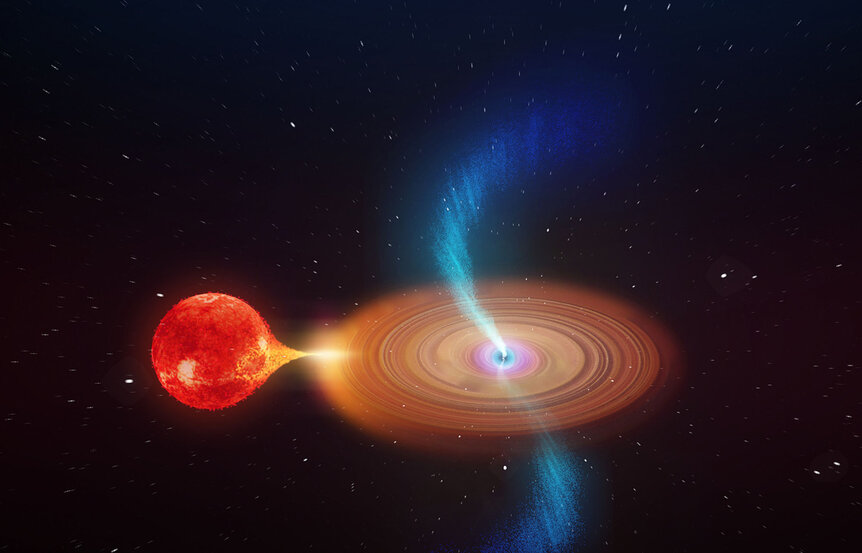Create a free profile to get unlimited access to exclusive videos, sweepstakes, and more!
Astronomers watch an active black hole dragging spacetime around it

Just under 8,000 light years from Earth sits a monster: A black hole that is actively eating its companion.
This pair of stars — one dead, the other dying — is called V 404 Cygni. The black hole formed long ago, when an extremely massive star exploded. The core collapsed, leaving behind a black hole with a mass nine times that of our Sun. The other star is more like the Sun, though lower mass and cooler, but it’s nearing the end of its life and has started to swell up into a red giant. It’s a subgiant right now, a few times bigger than the Sun in diameter.
The star orbits the black hole in about 6.5 days. They’re so close together that the black hole’s gravity is pulling matter off the subgiant. That matter doesn’t fall straight into the black hole, though, because the orbital motion of the objects gives it a pretty decent sideways velocity. This material instead spirals around the black hole, forming a disk of material around it called an accretion disk.
Material close to the black hole moves incredibly fast, near the speed of light, while material farther out orbits more slowly. As slower matter in the disk rubs up against stuff moving faster, the friction is so huge it heats the disk to a temperature of millions of degrees, and it glows brightly across the electromagnetic spectrum from radio waves to X-rays.
The matter in the disk also generates a powerful magnetic field, which winds up like a tornado around the black hole. It’s so strong it can yank matter from the disk and blast it out in twin beams perpendicular to the disk; this stuff screams away from the black hole at a large fraction of the speed of light. Sometimes the material from the accretion disk feeding those beams hiccups, and you get a bigger blob of material ejected, which gets very bright and then fades over time as it moves away.
If your mind still isn’t ground into dust by the colossal power of this system, well, we’re still not done. Because now astronomers have determined that the direction of the jets changes, moving around by many degrees in just a matter of hours. Why? Because the black hole is literally dragging around the fabric of spacetime around it.
Black holes are known for their intense gravity of course, which can apply a huge force to material around it. But it turns out anything with gravity warps spacetime — that’s what gravity is, a dent in the fabric of space and time — and if that object is also spinning, it tugs on spacetime, wrapping it around itself. It's another weird outcome of General Relativity.
Think of it like a bowl with honey in it. If you put a ball in the honey and spin it, it will drag the honey around with it due to friction. The stuff very close to the ball moves faster than stuff farther out. The same thing happens with a spinning object in space; the space nearest the object will be dragged along with the spin. This is called the Lens-Thirring Effect, or more colloquially, and more colorfully, frame dragging.
The spinning Earth does this to space around it, but the effect is tiny because Earth is so low mass. But a black hole has huge gravity, and the effect can be quite profound around it.
As the black hole in V404 Cygni spins, it drags space around with it. But here’s the really weird part (and we’ve set a pretty high bar for weird here): The black hole isn’t spinning straight up-and-down with respect to the accretion disk, and that affects how matter is flowing very close to the black hole.
The black hole is tilted relative to the orbit of the subgiant star around it. The material coming from the other star stays in the orbital plane of the two objects as it approaches the black hole, but as it gets very close it feels the effect of frame dragging, and gets torqued by it. The stuff near the black hole wants to orbit it in the plane of the black hole’s equator, so the disk warps several degrees very close in.
When you apply a force to a spinning object (like material in the disk) it starts to precess — it’s like the wobble in a top as it spins, due to friction with the surface it’s spinning on. The axis of the material spinning around the black hole wobbles, making a circle in the sky. The Earth does this due to the tug of the Moon’s gravity, and the Earth’s axis makes a slow wobble once every 26,000 years or so. The forces in the black hole and frame dragging are so huge, though, that the disk of material near the black hole precesses every couple of hours. This means the direction the jets of material moving outward moves as well, making a complete circuit once every 2.6 hours at most.
This is just what the astronomers saw! They used Very Long Baseline Interferometry —essentially combining the power of radio telescopes around the world linked to together to create a virtual telescope the size of the Earth — to observe the material blurping out in the jets from the black hole, and literally could see the jets tipping back and forth over the course of just a couple of hours, sending blobs of material first one direction, then another. The jets wobbled by about 36° back and forth as they gyrated, sending material off in different directions.
A good question still remains, though: Why is the black hole tipped with respect the accretion disk? It’s possible that when it formed in the center of the supernova billions of years ago, the huge explosion was just a wee bit off-center. This asymmetry can create a pretty big kick to the core of the star, so when it collapsed to form the black hole it got tipped over by about 18°. Now, as it precesses, the jets spray out like a garden sprinkler, making that 36° wobble (18° one way and 18° the other).
Yeah. I know. Trust me, it’s hard for anyone to think on these scales.
But not impossible. This is what scientists do.
Still, there’s nothing about this story that isn’t mind-destroying. Black holes, warped spacetime, matter-vaporizing temperatures, blobs blasting away at a big fraction of the speed of light, virtual telescopes the size of planets, titanic explosions, and the literal stripping of material from one star to another.
But what I love about all this — on top of the sheer awesome reality of it — is that we can figure this out. The Universe is a very strange place, with stuff going on that is so far outside our concept of normal that without science it would all seem like magic. But that’s the beauty of science: It helps us understand these things, and what used to seem like fantasy becomes just what the cosmos does.
And what it does is no less amazing because of that. I say it’s even more astonishing, because now we can see the mechanisms behind these things, and discover how they work.
There is still mystery, awe, and beauty there… and on top of that we can add understanding.
















